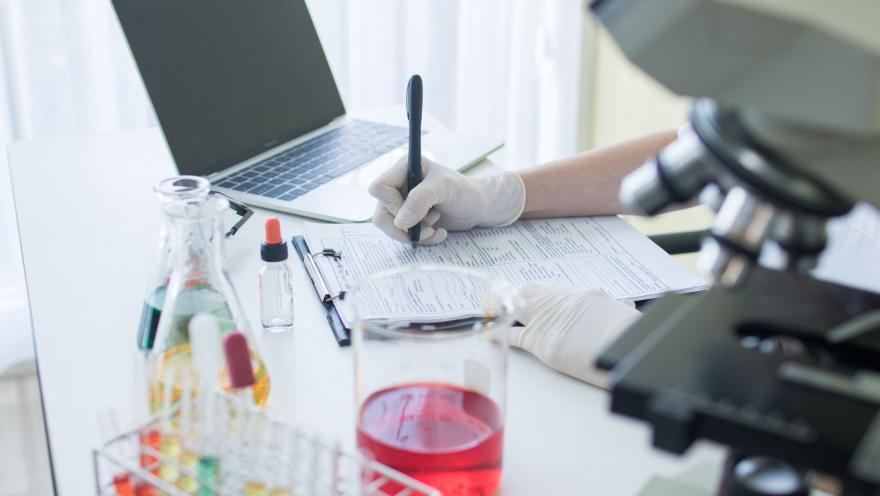The ALS Association and ALS Finding a Cure® have awarded seven new grants worth a total of $2 million over the next three years to support the development of early diagnostics for ALS.
Despite being first defined more than 150 years ago, there still is no ALS-specific diagnostic test. It remains a diagnosis of exclusion. This means people must undergo a battery of tests designed to rule out other conditions with similar symptoms. As a result, it can take roughly a year for someone with ALS to receive the correct diagnosis – and sometimes even longer.
During this time, individuals are frequently seen by numerous health professionals and can receive unnecessary (and expensive) surgical procedures and medications. Diagnostic delays can also result in loss of physical function, lack of access to disability benefits and missed opportunities to participate in clinical trials.
To address this problem, ALS Finding a Cure launched the Early ALS Diagnostics Initiative to identify promising molecular, digital, imaging and electrophysiological diagnostic approaches for ALS. The ALS Association awarded ALS Finding a Cure a Partnership Grant worth $500,000 to increase the number of projects supported by the initiative and expand its reach internationally.
Merit Cudkowicz, M.D., chief medical officer of ALS Finding a Cure, reinforced the importance of the Early ALS Diagnostics Initiative.
“Now is a time of unprecedented promise for the field of ALS research and drug development,” said Cudkowicz, who serves as chief of neurology at Mass General Hospital and the Julieanne Dorn Professor of Neurology at Harvard Medical School. “This collaboration has made possible the support needed to shorten the time to diagnosis. This has been a long-time interest for ALS Finding a Cure, and we look forward to advancing a solution towards this key need for the field.”
Early Diagnostics Grant Recipients
James Berry, M.D., Massachusetts General Hospital / Harvard Medical School – The investigators are aiming to develop a decentralized and open innovation platform to remotely monitor individuals at higher risk of developing ALS. Assessment measures will include limb activity, speech and cognition/behavior.
Erez Eitan, Ph.D., NeuroDex – The goal of this project is to develop a blood test that could be used to diagnose ALS early in the disease process by measuring levels of specific messenger RNAs regulated by TDP-43. TDP-43 is a protein normally located in the nucleus of cells in the brain and spinal cord that helps control the proteins produced from a number of different genes. However, in approximately 97% of people with ALS, clumps of misfolded TDP-43 are commonly found in the cytoplasm of motor neurons, affecting mRNA production.
Roisin McMackin, Ph.D., Trinity College Dublin, Ireland – The research team will measure nervous system function of individuals with C9orf72 mutations but no ALS symptoms using electroencephalography (EEG) and transcranial magnetic stimulation (TMS) to identify which functional changes can help predict disease development. C9orf72 mutations are the most common genetic cause of ALS.
Patrick Oeckl, Ph.D., Ulm University Hospital, Germany – The aim of this project is to study cerebrospinal fluid (CSF) samples taken from people with ALS-linked genetic mutations but no symptoms to identify small protein fragments called peptides that are associated with the early stages of ALS development. These results could then be used to develop a diagnostic test.
Ghazaleh Sadri-Vakili, Ph.D., Massachusetts General Hospital / Harvard Medical School – The researchers are focused on identifying “breakpoint gene fusions” associated with ALS in blood and CSF samples to serve as early biomarkers of the disease. These events, which link two previously independent genes, are frequent in cancers and have been used as biomarkers in oncology to stratify disease and to improve treatment through precision medicine.
Ian Thrippleton, Ph.D., NemDx – Through this project, the researchers are aiming to develop a comprehensive blood test for ALS that will measure TDP-43 activity along with several other biomarkers associated with both sporadic and familial ALS. They will then use this test to determine whether this combination of biomarkers can help divide people with ALS into subgroups.
Philip C. Wong, Ph.D. Johns Hopkins University – The research team will lay the foundation for a diagnostic test by measuring CSF levels of an abnormal protein that is produced when TDP-43 is lost from the nucleus of neurons and stops working normally. They will then determine whether the assay is sensitive enough to detect this abnormal protein in blood samples.

